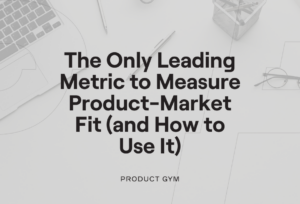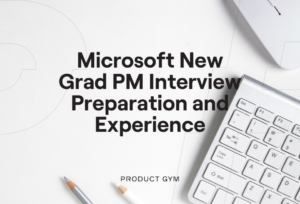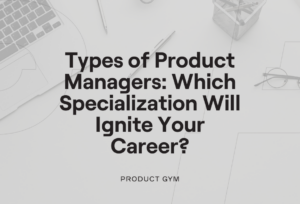Let’s take a look at a day in the life of a Product Manager. Specifically, of Tim MacGougan, Chief Product Officer at Hinge. Tim sat down with us to share a glimpse of the challenges he faces on a day-to-day basis.
About Tim MacGougan
Tim MacGougan is a product leader with a demonstrated background in UX Strategy and Consumer Insights. Prior to his role as Chief Product Officer, he was Vice President of Product and a Product Manager at Hinge.
Tim has a Bachelor’s Degree in Marketing from the University of Richmond.
Product Gym: What is your definition of Product Management?
Tim: The goal of Product Management is to figure out, within your own jurisdiction, what problems exist, then which to focus on and why, and finally how to solve them. Product Management requires working with design and engineering teams to put out the best iteration of how you will solve those problems.
Tim MacGougan’s Day in the Life of a Product Manager
Product Gym: As Chief Product Officer at Hinge, what are the typical challenges you face on a daily basis?
Tim: I have two primary functions, one as a Product Manager, where I’m responsible for finding problems and developing solutions, rinse and repeat. And, I am head of product, where I’m responsible for translating business goals into product goals. Then setting longer-term vision and medium-term roadmaps. Each function has its own challenges – our complicated ecosystem is tricky to build features into, and our industry and business is evolving quickly, which makes it hard to see far into the future of – and balancing those two roles is itself a daily challenge.
I spend a lot of my time on data analytics where the challenge is understanding user behavior. It is taking quantifiable data and results and building a narrative around it to understand the numbers you that are seeing, which can involve focus groups, surveys and a lot of user communication. As we move into solution development, I help the design team with UX challenges during the product’s design phase and work with engineering to find scope efficiencies.
Communicating with the team is a day-to-day challenge. It is having the engineers and marketing team buy into what you are doing, and including them in the process of deciding what next steps should be taken. You have to come up with an inclusive process that proactively collects feedback from around the company to not only convince them that what you are doing is right, but also to do the right thing based on their expertise.
Product Gym: How do you go out there and find a way that works?
Tim: We are a small team, so we are able to do things differently than a big team would. There is no one right way to do things since you have to be open to changing your process and reacting to problems with it. It is not about having the exact right process, but about being open about finding ways to improve that process. If you have that mindset, then you will naturally evolve your process into something that works for your company.
I will usually move features through three different phases. First, I pitch the company on a problem we should solve. I present all the data we have, focus groups, metrics, and a narrative behind the problem. It is usually on a collaborative document, where people can comment with new ideas on how to understand that problem or alternatives to that problem.
Once there is a certain amount of buy-in on that problem, then I will present a concept for a solution. Once people are bought in on the concept and the problem, then I can begin to develop a more typical spec. You want to get the right feedback from the right people at the right time. It is your job as a Product Manager to create an environment where you can get that.
Product Gym: How were you able to provide the end-user with a much more relevant and valuable experience compared to your competitors, especially since they launched at the same time as your product?
Tim: Part of it was identifying a unique need. Coffee Meets Bagel is probably one of the only ones trying to meet that same need. Tinder and Bumble are a little bit more fun and adventurous, rather than focusing on creating meaningful connections or relationships. We thought, “People want this. Nobody is really serving this very well. Maybe we can.”
We do not really want to have a silver bullet thing. We try to build thoughtfulness into the product from start to finish. On Hinge, you do not say “yes” to a whole profile, you pick something. That turns a lot of “maybe’s” into “no’s”, but we think that is good. That way when you do match with people, it is a signal of real interest and not just noise.
On profiles, we think we show personality better than our competitors, especially through written answers to our prompts, which helps create an environment where you know which people are actually interested in you. By liking content, you create a conversational starting point. We offer a “Your Turn” system, which helps you keep track of who to respond to, etc. but you can hide these notifications if you want to because that is an active choice. It is all about making active choices, yes or no, and not passively deferring or procrastinating.
All of those things contribute towards a product suited to meet a need that people feel is not being satisfied by larger competitors.
Product Gym: Do you think having a customer-insights background makes you a better Product Manager?
Tim: I think every background in Product Management comes with its strengths and weaknesses. For me, my background has made it so that the impact on users is not abstract. I definitely focus on individual user experience. I am able to empathize very well and anticipate how users may react to something.
The downside is that it is very easy for a vocal minority to sway you. It is easy to focus on building a faster horse rather than building a car. You can be led down the wrong path by complaints. You have to understand what expertise you are bringing, but also what blindness you are bringing. Compensate for that blindness with the expertise of your team around you. Ultimately you have to become enough of a generalist that you are able to work with design, data, marketing, customer service, and engineering to find the right solution.
Product Gym: Are there any books, blogs, podcasts, or other resources you would recommend that had an impact on you coming up as a Product Manager?
Tim: The only newsletter that I regularly follow is Nielsen Norman Group. They are particularly focused on UX, and they are very research-driven. They are very reputable because typically what they put out is backed up by lots of data and research.
A book that helped me was The Lean Startup. It encourages you to be efficient and think about things in a Minimum-Viable-Product way all the time, especially when you are working in a startup. The Design of Everyday Things, Predictably Irrational, Don’t Make Me Think, and Nudge are all particularly UX-based. These are also helpful towards thinking about the product you are managing and would be useful for somebody even without that UX background.
A Day in the Life of a Product Manager
For more perspectives from professionals and experts in product, check out our Expert Insights on the Product Gym blog. Prefer to learn from real interactions with your peers? Getting into product and succeeding as a PM is hard work! We put together this community group so that you can network and find the support you need.



